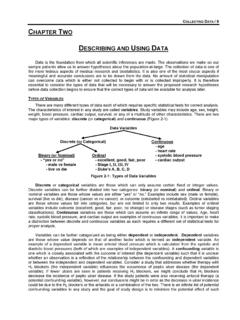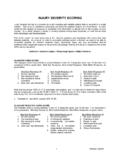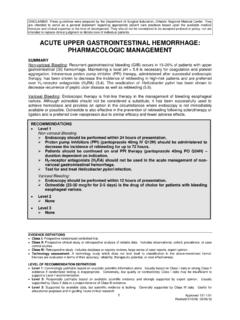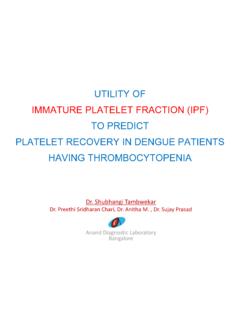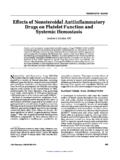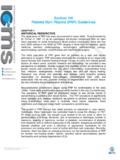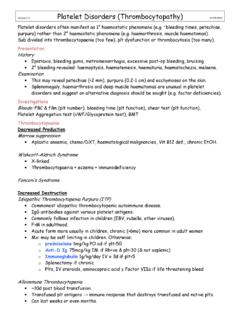Transcription of ANTIPLATLET AGENT REVERSAL IN ADULTS WITH …
1 DISCLAIMER: These guidelines were prepared by the Department of Surgical Education, Orlando Regional Medical Center. They are intended to serve as a general statement regarding appropriate patient care practices based upon the available medical literature and clinical expertise at the time of development. They should not be considered to be accepted protocol or policy, nor are intended to replace clinical judgment or dictate care of individual patients. ANTIPLATLET AGENT REVERSAL IN ADULTS WITH. TRAUMATIC INTRACRANIAL HEMORRHAGE.
2 SUMMARY. The use of antiplatelet agents (such as clopidogrel or aspirin) has been steadily increasing. The use of these agents raises concern for inadequate platelet aggregation in the setting of acute hemorrhage, especially intracranial hemorrhage (ICH). The purpose of this guideline is to provide recommendations for the evaluation and management of patients on aspirin or ADP-inhibitors ( clopidogrel, prasugrel, ticagrelor, etc ) who present with acute spontaneous or traumatic ICH. RECOMMENDATIONS. Level 1.
3 Discontinue antiplatelet agents when traumatic intracranial hemorrhage is suspected. Level 2. None Level 3. Aspirin therapy testing and/or REVERSAL is NOT necessary. Do NOT transfuse platelets for patients with antiplatelet-associated intracranial hemorrhage who will NOT undergo a neurosurgical procedure, regardless of type of platelet inhibitor, platelet function assay (PFA) results, hemorrhage volume, or neurologic exam. In patients with traumatic brain injury (TBI) AND known history of ADP-inhibitor antiplatelet therapy ( clopidogrel (Plavix), prasugrel (Effient), ticagrelor (Brilinta), ticlopidine (Ticlid), etc ) AND who have a planned neurosurgical procedure: Check baseline PFA-Plavix AND if POSITIVE: Administer 1 unit of apheresis platelets (1 unit = 6-10 pack) IV x 1.
4 Transfuse platelets at the time of maximal desired benefit In patients with TBI AND unknown history of antiplatelet agents AND who have a planned neurosurgical procedure: Assess risk for administration of ADP-inhibitors (See algorithm). High Risk: Treat the same as known history of ADP-inhibitors Low Risk: o Check STAT PFA-PLAVIX assay o Administer 1 unit of apheresis platelets if the assay is positive Minimal Risk: No further action Consider the addition of one of the following options in patients with renal dysfunction ( BUN > 20 and/or serum creatinine >2) AND active bleeding: Desmopressin injection (dDAVP) mcg/kg IV in 50mL NS x 1.
5 OR Cryoprecipitate 1 unit IV STAT. EVIDENCE DEFINITIONS. Class I: Prospective randomized controlled trial. Class II: Prospective clinical study or retrospective analysis of reliable data. Includes observational, cohort, prevalence, or case control studies. Class III: Retrospective study. Includes database or registry reviews, large series of case reports, expert opinion. Technology assessment: A technology study which does not lend itself to classification in the above-mentioned format. Devices are evaluated in terms of their accuracy, reliability, therapeutic potential, or cost effectiveness.
6 LEVEL OF RECOMMENDATION DEFINITIONS. Level 1: Convincingly justifiable based on available scientific information alone. Usually based on Class I data or strong Class II. evidence if randomized testing is inappropriate. Conversely, low quality or contradictory Class I data may be insufficient to support a Level I recommendation. Level 2: Reasonably justifiable based on available scientific evidence and strongly supported by expert opinion. Usually supported by Class II data or a preponderance of Class III evidence.
7 Level 3: Supported by available data, but scientific evidence is lacking. Generally supported by Class III data. Useful for educational purposes and in guiding future clinical research. 1 Approved 03/15/2011. Revised 09/01/2012, 02/22/2017, 4/9/2017. INTRODUCTION. The antiplatelet agents, including aspirin, clopidogrel prasugrel, ticagrelor, ticlopidine, and others have a number of clinical applications including decreasing risk of atherothrombotic events such as myocardial infarction and stroke (1). Aspirin and clopidogrel are the two most widely utilized agents today, frequently in combination therapy.
8 Ticlopidine, due to a number of severe adverse events including neutropenia, agranulocystosis, and thrombotic thrombocytopenia purpura, is rarely used (2). Aspirin exerts its effects through inhibition of cyclooxygenase-1 (COX-1) which prevents the conversion of arachidonic acid to thromboxane A2 (3). Aspirin achieves platelet inhibition within 10 minutes following administration of a single dose. Aspirin results in an irreversible inhibition of platelet aggregation which persists for 5-7 days following discontinuation of aspirin (the time required for the body to release at least 20% new circulating platelets) (1).
9 In contrast to aspirin, clopidogrel, prasugrel, ticagrelor, and ticlopidine exert their antiplatelet effects by binding to the adenosine diphosphate (ADP) receptor on platelets preventing ADP from binding and activating glucoprotein GPIIB/IIIa which is necessary for platelet activation (2,4). Clopidogrel has a slightly slower onset and typically achieves maximal platelet inhibition (40-60%) at 7 days after initiation of therapy (1). If a loading dose of 300-400 mg of clopidogrel is administered, platelet inhibition occurs within 2-5 hours (4,5).
10 The result of clopidogrel administration is irreversible inhibition of platelet aggregation that will remain effective for the lifespan of the platelet (7-10 days) (4). Prasugrel, similar to clopidogrel, is also an irreversible inhibitor of the ADP P2Y12 receptor. It has an onset of 30 minutes after a loading dose and duration of effect based on the lifespan of the platelets (6). Ticagrelor reversibly binds ADP P2Y12 receptor with an onset following loading dose of 30 minutes and duration of 24-60 hours (7).


